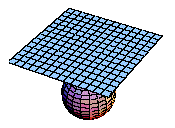Understanding 2 Dimensional Space
Understanding 2 dimensional space
By Engineer Saviour – Blaze Labs
 Let’s now start analysing a 2D case, that of the classic Flatland example, in which a person lives in a 2D universe and is only aware of two dimensions (shown as the blue grid), or plane, say in the x and y direction. Such a person can never conceive the meaning of height in the z direction, he cannot look up or down, and can see other 2D persons as shapes on the flat surface he lives in.
Let’s now start analysing a 2D case, that of the classic Flatland example, in which a person lives in a 2D universe and is only aware of two dimensions (shown as the blue grid), or plane, say in the x and y direction. Such a person can never conceive the meaning of height in the z direction, he cannot look up or down, and can see other 2D persons as shapes on the flat surface he lives in.
Now we know that 3D space exists, and can conceive that, because we see each other in 3D space. So, what does a 3D reality sphere look like into a 2D plane? The answer is again graphically shown in the animation, which shows a circle expanding and contracting depending on which slice of the sphere intersects the 2D observation plane. In the 2D plane, the thickness of the plane tends to zero, but is not absolute zero. There must be enough thickness for the circle to form and be observed. Thus, the 3D sphere is being differenciated with respect to one of its spatial dimensions (z in our case) across its diameter. Actually, in the special case of a sphere, it could be intersecting the plane at any angle to the z axis, and still be perceived as a perfect circle in 2D. For the person that lives in 2D, the only way to recognise such a 3D structure is through integrating all the circles he sees, on top of each other. But here is the problem, he cannot imagine anything ‘on top of each other’.
A clever 2D guy has just one simple way to refer to this z-axis, which is constantly differenciating the 3D object, and that is TIME.
I admit this concept is quite hard to grasp, especially when one moves on to describe a 4D universe differenciated by a 3D space, with both real and imaginary axis. The imaginary space dimensions can be pictured as follows. Just try to imagine a person in front of a 2D plane surface, but this time a mirror surface. The person is equivalent to the real part and his image in the mirror is equivalent to the imaginary part. Imagine also that such a mirror is present everywhere he can possibly move. So, the person becomes DEPENDENT on the existence of his imaginary component. That is, if the image is no longer present in the mirror, then one can deduct that the person can no longer exist in reality! Now this was an example of a 3D image reflected on a 2D plane (the mirror).
Next Page: Understanding 4 Dimensional Space
Previous Page: Understanding 1 Dimensional Space
One Comment
Leave a Reply
You must be logged in to post a comment.

so um. everything i see is mearly the 3d (3d+1) view of an n-dimensionsal object?
if i got hat right the universe actualy make a little more scence as it obviouly makes no scence at all lol